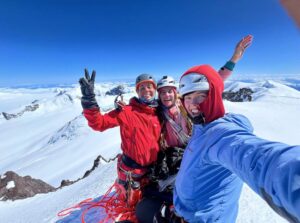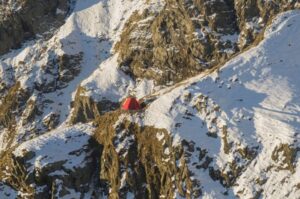By jumping into the water, brothers Dawid Andres and Hubert Kisiński celebrated their first encounter with the Amazon. There would be nothing unusual, if not for the fact that the Lake Ticlla Cocha, in which they were swimming, is giving rise to the greatest river in the world, and is located at an altitude of 5,142 meters (16,870 ft) above sea level.
Biking in the Amazon
(Piotr Chmielinski) By jumping into the water, brothers Dawid Andres and Hubert Kisiński celebrated their first encounter with the Amazon. There would be nothing unusual, if not for the fact that the Lake Ticlla Cocha, in which they were swimming, is giving rise to the greatest river in the world, and is located at an altitude of 5,142 meters (16,870 ft) above sea level.
After a tortuous journey through the Peruvian Andes, reaching here, hardly anyone would think about anything beyond the effects of altitude sickness and bitter cold – at night the temperature falls to about minus 20 degrees Celsius; usually the lake is covered with a sheet of ice at the sunrise; during a day temperature raises only to the upper single digits.
Noteworthy is another fact. The travelers from Zawarcie near Gorzow, Poland arrived at the source of the Amazon River on bicycles, which makes it the first such a feat in the history of exploration of the river. It is here, at the foot of Mount Mismi, at the Lake Ticlla Cocha, where they started their cycling expedition on the Amazon. However strange the statement “Biking the Amazon” may seem, Dawid and Hubert actually are planning to pedal on the most of Amazon water using specially designed bicycles.
The cheapest by bike
“I want to experience a great adventure. As far as I know, no one has ever traveled Amazon by bicycle. However, that was not planned, it just turned out to be the cheapest way” – Dawid, 40-year-old enthusiast of travels around the world replied to my question about the purpose of the expedition.
Dawid is a man with the soul of a globetrotter. He undertook various activities to pursue his passion for discovering new and distant places on earth. The real school of life proved to be working on board of a passenger ship, though the hardships, he says, “we’re compensated by the opportunity to visit interesting places and meet people from all over the world.” When he finally left the deck of the ship for good, he moved to the United States.
He was not done, however, with dreaming about the real adventure and proving himself. “I always wanted to experience something extraordinary,” – he says. Not surprisingly, the motto of the Amazon expedition has become a word that once read somewhere: “Twenty years from now you will be more disappointed with what you did not do rather than with what you did. So loose the moorings; leave the safety of the cozy cove. Catch the wind in your sails. Explore.”
First, it was to be the Middle East. The direction of the planned expedition changed dramatically after reading books on Amazon (“Running the Amazon” by Joe Kane and “Amazonia Piekielne Piekno” by Rafal and Sylwia Kośnik). There was still to be determined how the Amazon is conquered. “Initially, we wanted to kayak the entire river; the mountain part in white water kayak and lowland section in the sea kayak. The plan quickly collapsed due to lack of experience in navigating whitewater rivers” – he recalls.
Then, came the idea for the bike ride through the mountain areas through which the river flows, then kayaking already “flat” segment. The costs associated with purchasing and transporting sea kayaks also eliminated that concept. Therefore only bicycles remained. “Immediately, there was a technical problem – how to bike the river? Soon they came up with an idea to build a portable bicycle, which can move both on the road and on the water. And…..the Amazon Bike was created.
Amazon Bike
In the mountain sections of the Amazon, cyclists have to bike along the shoreline of the river. When they get to the point where the river loses its mountain character, “ordinary” bicycles turn into “pedal boats” and then the journey will take place already on the river itself.
An Amazon bike resembles a catamaran. A frame without wheels is mounted on two 3-meter long tubes made of material used to build rafts. Their total buoyancy is 480 kilograms. The drive is connected to crank chain. The vessel is equipped with rear chambers, which transport the traveler’s possessions. The average speed of this bicycle pedal boat is about 6 km/h, although the speed will be adjusted when the amphibious equipment will be installed.
The bike has been subjected to tests on Warta River in Poland. But the most important test will be on the broad waters of the Amazon. I’m not sure how it will cope with eddies and whirlpools in the river, and then with the ocean waves close to the Atlantic Ocean. This challenge raises my biggest concern. “The bike mounted on the frame, creating a sort of catamaran will be unsinkable. In particular, I’m afraid the most about the power of the drive; I think this might be our biggest problem “ – says Dawid.
Bicycles will be brought to Peru by a friend of Dawid’s, Marek Pielech, who originally was to accompany them from the beginning of the expedition, but the birth of his son changed plans. Marek will join the expedition in San Francisco, the place where the Amazon leaves the Andes.
For his Amazon trip, therefore, Dawid went together with his eight years younger brother, Hubert. That Dawid selected his brother was not solely decided on fraternal ties, but more practical considerations, as Dawid jokingly tells: “Choosing Hubert was not due to the fact that he is my brother. He has extraordinary ability of finding a reasonable solution in situations with no way out. He needs five minutes to figure out how to fix the thing he sees for the first time in his life and Hubert is very brave.”
To the proposal about joining the expedition, he reacted instantly – four days after the phone he was already in the United States, and from there, both brothers would fly to Lima, Peru. “The concept of organizing the expedition, however, is completely foreign to him, but he knows what he wants and he is committed to the project” – still jokingly says Dawid.
On September 6th, they traveled by bus from Lima to picturesquely situated on the Pacific coast small town Camana. From there, they moved inland. Due to the knowledge about the area and captured by spontaneous response to my question about the route of the expedition: “In the footsteps of Chmielinski, except that on the bike,” I enthusiastically “joined” as an observer, this extraordinary expedition – of course at a distance.
I suggested to “start biking from Arequipa and from there, reach Chivay and then Lari. From Lari the route would be to the pass on the watershed between the Pacific and the Atlantic (the path between Lari and Cailloma). From the pass, if you could bike along the creek Apacheta (may not have water at this time of year) to connection with the stream Carhuasanta. Here, I would recommend, that you left the bikes and hike up Carhuasanta to its source – Lake Ticlla Cocha. It is a constant source of the Amazon, according to recent confirmations of National Geographic in 2014 (https://news.nationalgeographic.com/news/2014/02/140213-amazon-river-length-source-maps-science/) “- I advised in response to a request for assistance in marking out the route leading to the source of the Amazon.
Determining the travel path with Dawid reminded me how, exactly thirty years ago, I wandered around the same vicinity in search of these places before and during the expedition from the source to the mouth of the Amazon. With curiosity and emotion I looked at the picture of Dawid and Hubert standing, of course, with their bicycles on the Inca Bridge (Puente del Inca Q’eswachaca) above the Apurimac River. From the same bridge, thirty years ago I hung down dozens of meters above the rushing water when one of the “rope spans” broke off to form a large hole in it. Now the bridge is renovated and looks solid.
From Camana through Arequipa and Chivay, in a few days, the brothers arrived to the village of Tuti. From there they departed towards Mismi, “to get wet feet at the source of the Amazon in Ticlla Cocha Lake and start their journey to the Atlantic”. We already know that they got their feet wet in the lake after they reached the source not on foot, as I suggested, but on their bikes.
When asked how long it will take the expedition, Dawid replied: “I think like Filipinos (his wife is from the Philippines), and now like also Peruvians – will continue it until we reach Atlantic. But really, I hope that it will happen in 6-8 months. ”
Piotr Chmielinski
Washington DC, October 1st, 2015






